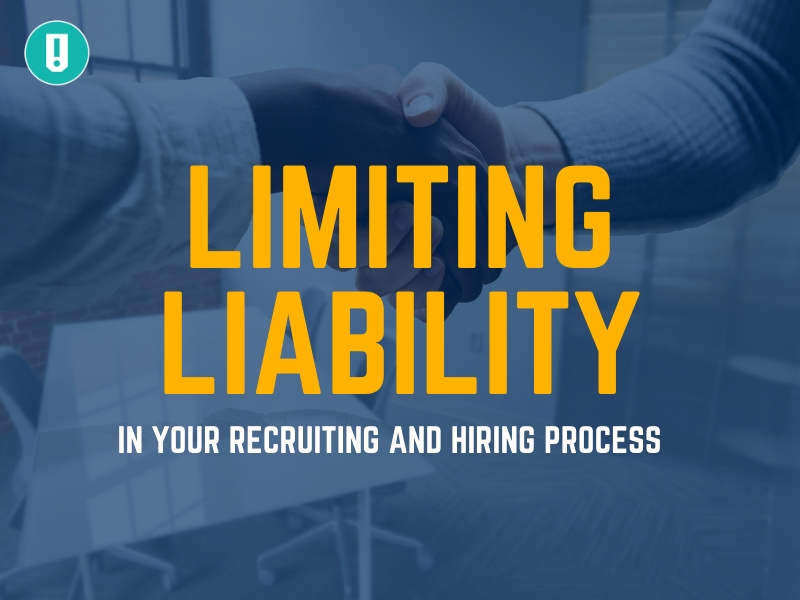Hiring and recruiting pose a variety of challenges. As of the end of 2019, the unemployment rate hovered at a low 3.5%, and over 60% of employers are willing to stretch their eligibility guidelines to hire the right candidates.
As ideal candidates become harder to find, many companies are recruiting in new ways. The key is to keep these strategies in line with legal requirements so your business isn’t the target of a lawsuit.
How can you limit your liability in recruiting and hiring in the challenging job market of the 21st century? Here’s what you need to know.
Use Social Media Carefully
Promoting a job opening on social media is an excellent way to get the word out about your business and its opportunities. However, you have to make sure you’re following the rules and advertising fairly.
LinkedIn is the easiest platform to use because it’s designed for those who are looking for work. You can also use Facebook and other platforms. Approximately 87% of employers recruit on LinkedIn, while 55% use Facebook and 47% use Twitter.
Using targeted promoted posts is the ideal way to make sure your job opportunity is seen by the largest number of qualified candidates. Their level of targeting available is incredibly detailed, but you have to use the data legally.
Of course, it’s obvious you don’t want to target only specific genders or races. But you also can’t target based on age, or make decisions based on information found in the profile before you meet the candidate face to face. Making sure you use social media recruiting wisely can not only give your business a wider range of applicants, but it can also protect you from legal mistakes.
Classify Employees and Contractors Appropriately
One way that many companies are finding qualified workers at a lower cost is by hiring contractors. 57 million American workers are part of the “gig economy”, meaning that they work as a contractor for additional income or more flexibility.
This can be a great opportunity to get professional-level help without a lot of the overhead that employees usually require. However, these workers have to be managed carefully to avoid running afoul of employment laws. For instance, if you classify someone as a contractor, you cannot treat them as an employee. You can’t require specific work hours or work locations, and you cannot claim a right to direct or control the way a contractor works.
The IRS has a 20-point test to determine if someone is an employee or a contractor. If you misclassify someone, you can face fines and legal cases from your worker.
Uber has been under a lot of pressure regarding this issue. In 2016 they faced a lawsuit from 400,000 drivers in California and Massachusetts and were going to pay a settlement of $100 million – until that settlement was deemed insufficient by another court. They have faced similar cases in other U.S. states and abroad. However, Uber is not alone. Cases have been brought against health aide companies, truck driving firms, and those that use janitors, dock workers, and more.
To avoid these types of lawsuits and liabilities, make sure you’re classifying employees appropriately. Don’t be a business that underpays staff and denies them the required benefits by calling them contractors when they are employees.
Maintain Fair Training and Avoid Bias or Gaps
Gender pay gaps have been an ongoing concern in businesses of all kinds – and in sports as well. Megan Rapinoe’s recent advocacy has brought the issue of bias and pay gaps back to the front page, and her lawsuit against the United States Soccer Federation sets a precedent of legal action to address unequal pay.
As a business, you not only want to avoid controversy but you want to do right by your employees. That’s how you attract and retain top talent over time.
What’s difficult is that it’s challenging to see your own bias. It can pop up not only in hiring but also in training, promotions, and networking opportunities. Run internal bias analyses on a regular basis and take corrective action as needed.
Protect and Destroy Paperwork in a Timely Manner
When people apply to your position, they provide a lot of personal information. This allows you to review qualifications, do background checks, and ultimately make your hiring decision. But what do you do with the paperwork when the process is over? Whether you keep applications on file or dispose of them, you need to make sure you protect everyone’s privacy.
Keeping applications on file can help you when similar positions come open in the future, but you need a business records retention process that keeps data safe. Resumes and other hiring correspondence can be a gold mine for hackers and data thieves.
Be sure you secure your applicant tracking system and have secure storage for any printed resumes or paperwork. Limit who can access these files to avoid embarrassing data breaches and legal liability.
Keep Your Recruiting and Hiring Liability Free
These four steps are the foundation of keeping your recruiting and hiring process free of missteps. Of course, there are other possible pitfalls as well. But by structuring your hiring process to bring in qualified candidates with a variety of backgrounds and personal experiences, you can protect yourself from liability and lawsuits.
Optimize your hiring process so you can bring in high-quality new-hires in any job market. You want your business to be poised for success in the 21st century and beyond!
Jori Hamilton is a freelance writer residing in the Northwestern U.S. She covers a wide range of subjects and with over 8 years of professional writing experience, she has taken a particular interest in topics related to Business, Marketing, SEO Best Practices, and Productivity. You can follow Jori on her Twitter and LinkedIn.







Leave A Comment